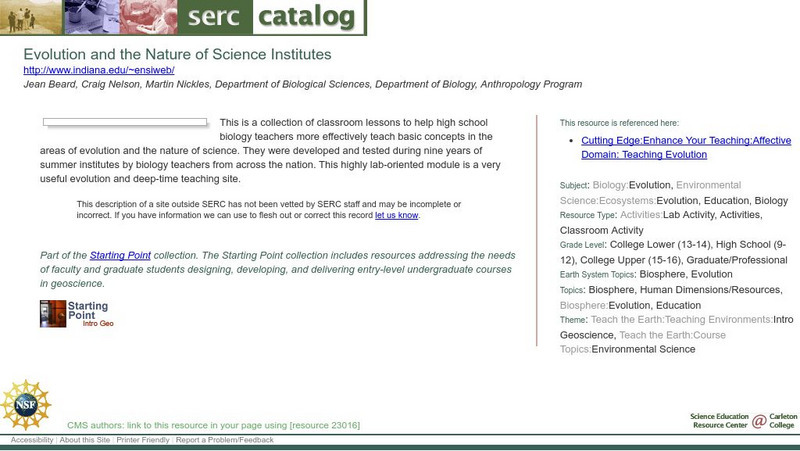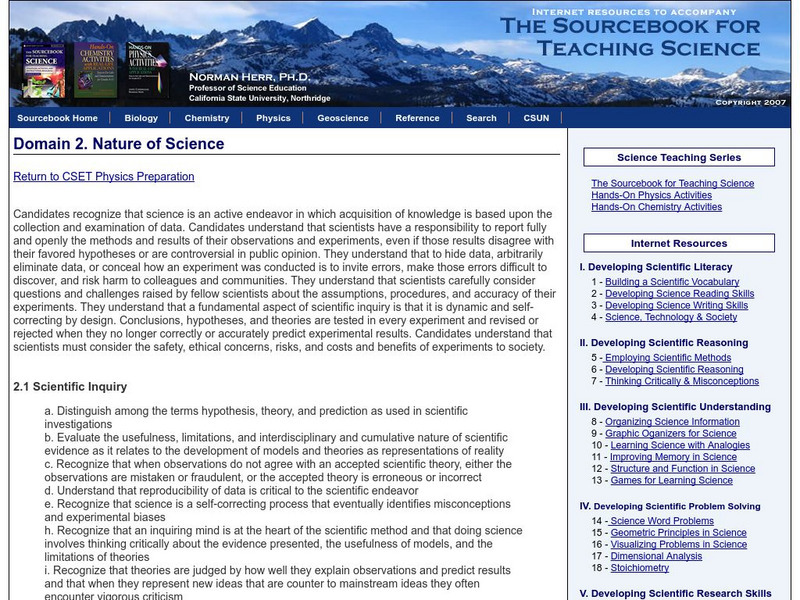Hi, what do you want to do?
Curated OER
Just How Small is a Nanoparticle?
Students determine the size of a nanoparticle. In small groups, they calculate the actual size of a particle shown in a photo, and discuss how they arrived at their answers.
Curated OER
Aerology- The Study of Mars
Learners investigate various aspects of the planet Mars. They examine a core sample that is simulated to make observations. Then compare the known sample with one that is unknown and differentiate between the two. Students hypothesize...
Curated OER
Measuring the Sun's Diameter
Students project and measure the suns image using a refracting telescope. In this sun's diameter lesson students calculate the magnification of the telescope and determine the diameter if the Sun.
Curated OER
Making Craters
Students study craters and identify the different things that characterize craters. In this crater lesson students create a model of an impact crater.
Curated OER
13 Ways to Tell Time Backwards
Young scholars explore different ways geological time can be measured: comparing the time dimensions for each method, the mechanisms of each method, and the materials used.
Curated OER
Where Should We Place Archaeopteryx?
High schoolers classify Archaeopteryx using pictures of actual fossils and scientist representations of how the animal might have looked. They compare Archaeopteryx's characteristics to those of the five extant vertebrate groups to...
Curated OER
Fossils-Where Should We Place Archaeopteryx?
Students explore an interactive computer activity that provides the opportunity to look at features of various groups of animals and determine where an extinct organism might be classified.
Curated OER
Seed Selection for Genetic Variation
Students will research the origin of corn, analyze factors that contribute to shorter and longer growing seasons, and use the scientific method to answer the question: Did seed selection contribute to the successful movement of corn from...
Curated OER
What's Your Latitude?
Students measure the height of items using an astrolabe. In this latitude lesson students construct a sextant and determine height and latitude with it.
Curated OER
A Tree Full of Ancestors
Young scholars study human evolution and the scientific process. They complete the Origins of Humankind Web activity to become familiar with the hominid species as well as the associated evidence found, in the form of fossils and artifacts.
Curated OER
How Can You Study Things You Can’t See Like: Atoms?
Students simulate how scientists studied things they can't see like atoms. In this chemistry lesson, students predict what is inside the numbered obsertainers. They design a way to investigate what's inside without opening it.
Curated OER
Cladistics Is a Zip...Baggie
Students explore how the grouping of organisms based on their shared derived characters forms the basis of a cladogram.
Curated OER
Calculating the Average Mass of the Newly Discovered Element: Bean
Students determine the average mass of a new element using masses from three isotopes. In this chemistry instructional activity, students explain what an isotope is. They discuss their importance and uses.
Curated OER
Why Do We Need Vitamin C in Our Diet?
High schoolers compare/contrast the DNA sequence data of the rat GULO gene to the inactive human GULO gene. They translate and align the sequences, and propose a scenario to explain the occurrence of an inactive DNA sequence to that of...
University Corporation for Atmospheric Research
Ucar: The Nature of Science
This teaching box engages middle and high school students in the Nature of Science - what it is and what it isn't - along with activities to ensure engagement and enhance science understanding explicitly.
Science Education Resource Center at Carleton College
Serc: Rutherford's Enlarged: A Content Embedded Activity on Nature of Science
Through a study of Ernest Rutherford's experiments with atomic structure, students develop a deeper understanding of the nature of science. The activity is taken from a linked article by the author that was published in the Journal of...
University of California
University of California Museum of Paleontology: Nature of Science
A great beginner's guide to examining the nature of science. Covers the basics of how science helps us to understand the surrounding world.
McGraw Hill
Glencoe Biology: The Nature of Science: Self Check Quiz
Answer five comprehension check questions about the nature of science in this interactive quiz.
University of California
Understanding Evolution: Nature of Science
Understand the processes behind the nature of science.
Science Education Resource Center at Carleton College
Serc: Evolution and the Nature of Science Institutes
A collection of classroom lessons to help high school biology teachers teach evolution and the nature of science. This highly lab-oriented module is a very useful evolution and deep-time teaching site.
Science Education Resource Center at Carleton College
Serc: Science as Storytelling for Teaching the Nature of Science
For this activity, students first read an essay entitled Science As Storytelling, then respond to the questions accompanying it. The purpose of the lesson is for students to develop a deeper understanding of science as more than just...
American Association for the Advancement of Science
Science for All Americans Online: The Nature of Science
A detailed overview of how scientists look at the world. Written in a way that the average person can understand, it opens up the world of science to everyone.
Georgia Department of Education
Ga Virtual Learning: Ap Biology: Nature of Science
In this online course, students look at the big ideas and themes of biology and review how these ideas are used to develop scientific inquiry and research.
California State University
Csun: Nature of Science
This California State University Northridge essay on the "Nature of Science, the Scientific Method, and Measurement" includes a historical perspective.
Other popular searches
- History and Nature of Science
- The Nature of Science
- Nature of Science Biology
- Nature of Science Inquiry
- Nature of Science Physics
- History Nature of Science
- Genetics Nature of Science
- Teaching Nature of Science
- Nature of Science Weather
- Genetic Nature of Science
- Nature of Science Experiments
- Nature of Science and Weather




























